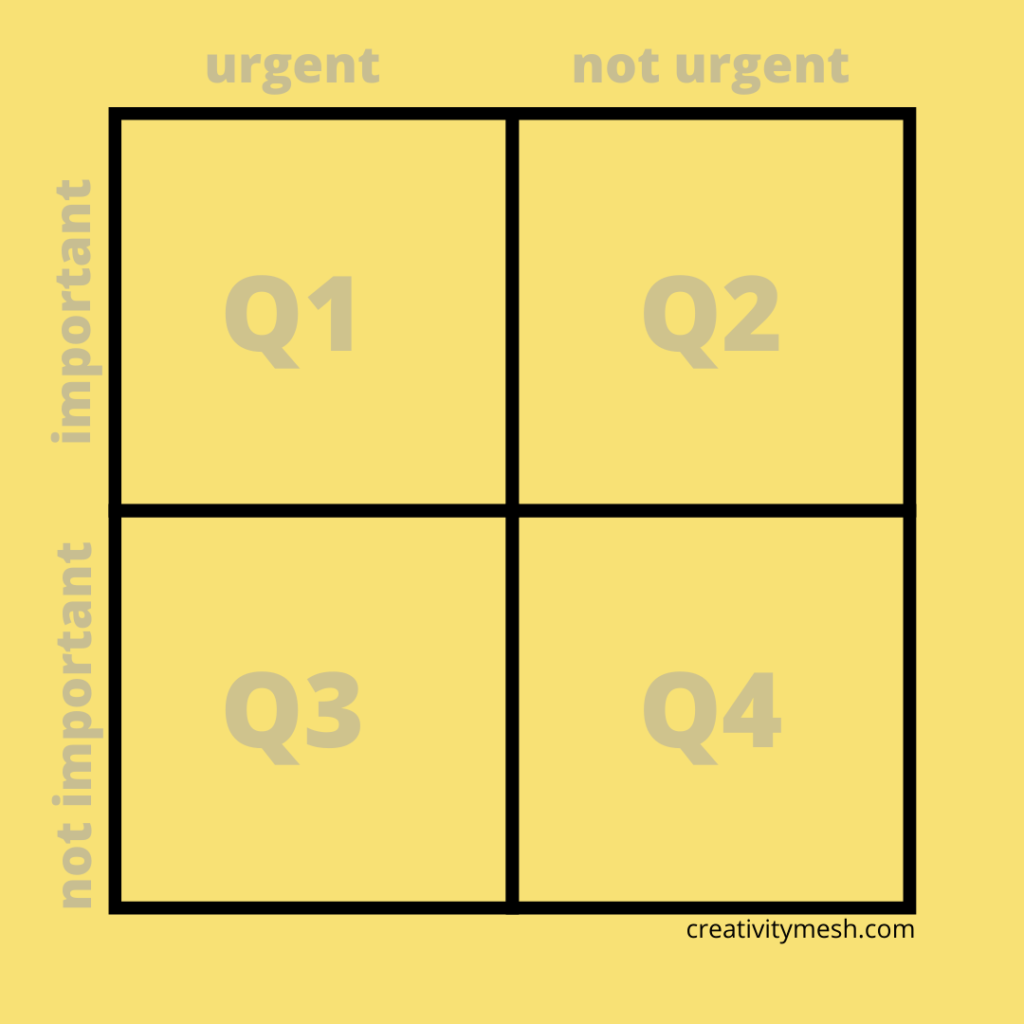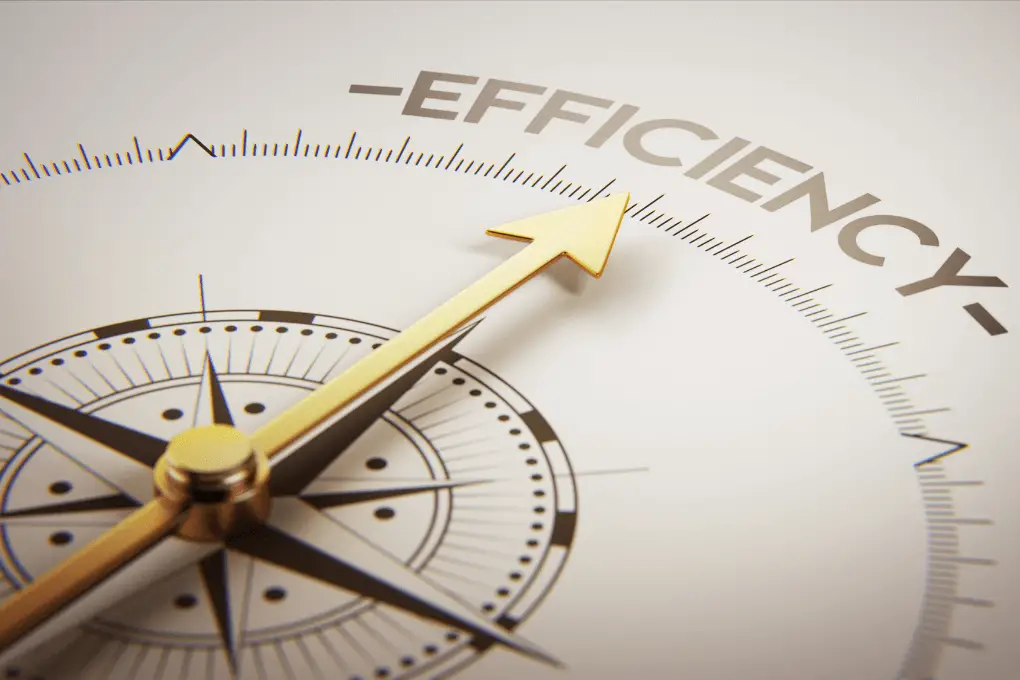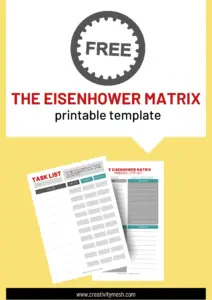So you’ve been told to use an Eisenhower Matrix to process and organize your tasks, and prioritize your workload. Great! You’re on your way to living a more productive life.
But before delving deep into the tool, there are a few things you need to know about it. (SPOILER ALERT: Some of these things might even surprise you!)
Read on to learn about Eisenhower matrix pros and cons, as well as a few extra tips that will make your life easier.
Grab your FREE Eisenhower Matrix Template (Printable) here.
[divider width=”full”]
Recommended Reading:
- Just Going Through the Motions? Here’s Your Way Out
- 16 Sure Signs of a Deep Thinker. Are You One?
- What is an Underachiever, and 5 Easy Ways on How to Overcome Being One
[divider width=”full”]
Why Use the Eisenhower Decision Matrix As A Productivity Tool?

Do you ever feel like you don’t have enough time to do things that you’ve always wanted to do? Have you been so overwhelmed by work that by the time you retire to bed, all you feel is exhaustion and not the slightest sense of accomplishment?
But, you know what? You’re not alone.
In a poll conducted by Gallup in 2015, about 48% of Americans feel that they don’t have enough time to do everything they need and want to do.
About 50% of American respondents think that they’re too busy – that they try to do at least two tasks simultaneously to catch up with their responsibilities in life.
What’s more: only about 20% of the responders feel it’s easy to accomplish daily tasks – according to this study.
I’m sure you’ve done everything you could to make the most out of your day. You’ve probably googled for the best productivity tools and hacks out there – and perhaps, tried them for a while?
Here’s the thing: sometimes, the most effective hacks are the simplest ones.
In this post, I’m going to teach a simple but highly effective time management tool so you could manage your time and energy better.
I’m going to dive deep into:
- The Top 3 Reasons Why We Don’t Make Much Progress Despite the Overwhelm
- The Glaring Difference Between Urgent Tasks & Important Tasks
- The Eisenhower Matrix Pros and Cons
- How You Can Use the Eisenhower Decision Matrix to Your Advantage
If you’ve been spending most of your life wasting away on “busyness,” now’s the time to turn it around.
3 Reasons Why We Barely Make Any Progress (And No, It’s Not Because of the Lack of Time)

“I don’t have enough time to {insert a task here}.”
“I’m too busy to spend a day off.”
“It’s never-ending work. I can’t spend a few hours to {insert leisure activity here}…”
You’ve probably heard them all – from your friends, family, and loved ones. Everyone’s too busy –
But some studies seem to say otherwise:
According to Atlassian.com: Only about 60% of the hours spent at work are spent productively.
On average, about 28% of work hours are spent on unnecessary or low-impact tasks.
Which brings us to another question: Are we truly swamped? Or do we just FEEL busy?
When we try to think about it – we should have total control over our time. After all, we each get to spend 24 hours a day – no more, no less.
If you’re not making much progress compared to your peers – what gives?
Three common causes distract us from doing what truly matters:
1. Lack of clarity and direction.

It’s no secret that goals help us with clarity, direction, and focus.
But one of the biggest problems with goals is this: if they are not defined enough to translate into actionable tasks, they are nothing more than dreams or wishful thinking.
The perfect analogy for this is to think about goals as physical destinations.
If you’re from New York, what do you need to do to get to, say, Hong Kong?
How will you get there?
What are the resources you need to get there safely?
The point is, a goal should be big enough to get you up and running – and clear enough for you to create an actionable plan out of it.
2. Being disorganized.

Disorganization and the lack of a systematized process cost us time and money. As a result, we pay dearly with a significant decrease in productivity and increased stress levels.
Say you’re a writer who needs to deliver an article within the next 24 hours. By the time you get down to write that masterpiece, you realize you couldn’t find your pen. You spend about 30 minutes looking for that pen when you could have spent that time writing and being productive.
Whether it’s a pen, or word processing software, or a workflow, you need to have a system so that everything you need is right where you want them to be when the time comes to do actual work.
3. Poor prioritization.

Lastly, we live in a world full of distractions. Humans as we are, without priorities, tend to favor doing things that give us instant gratification.
Bored? Many of us instantly whip out our phones to check what’s latest on Facebook, on Instagram…
And when we do, we often end up burning hours scrolling.
So setting the right priorities and sticking to them will prevent us from succumbing to time-wasters.
Now that we defined and got the problems out of the way let’s take a look at how we can address them.
Introducing The Eisenhower Decision Matrix.
What is the Eisenhower Matrix?
The Eisenhower Matrix is a structured way of looking at your tasks and responsibilities. It was created by former US President Dwight D. Eisenhower and was recently popularized by the bestselling author of The 7 Habits of Highly Effective People, Stephen Covey.
The principle behind the Eisenhower Matrix is simple and straightforward.
By assigning your priorities into four quadrants, you can easily manage your tasks based on importance and urgency.
Urgent vs. Important: What’s the Difference?

There’s a fine line that separates urgent tasks from important ones. That’s why many of us often get caught up doing and getting stressed over low-impact tasks that we THINK are all important and urgent.
But not anymore.
As a rule of thumb, urgent tasks are those pressing concerns that we need to address right away, while the important ones are the things we need to do to reach our biggest life goals.
Now that you know what separates the urgent from the important, are you ready to start planning?
How To Plan and Strategize For Optimum Productivity Using the Eisenhower Matrix
Planning and strategizing using the Eisenhower Matrix is easy. All you need is a pen and some pieces of paper.
To start, make a to-do list of all the tasks you need to accomplish within the day, week, or month.
Next, draw four boxes, similar to this one:

Then, assign labels:

In this matrix, each square represents a quadrant. Each quadrant, in turn, allows you to group tasks that you can classify according to urgency and importance.

From here on, we’ll call:
(1) The “Urgent-Important” Quadrant as Quadrant 1,
(2) The “Not Urgent-Important” Quadrant as Quadrant 2,
(3) The “Urgent-Not Important” Quadrant as Quadrant 3, and
(4) The “Not Urgent-Not Important” Quadrant as Quadrant 4
Now, go ahead, take your to-do list, and assign each task to a quadrant.
Remember, if a task needs to be addressed quickly, you need to add it to an “Urgent” Quadrant, which could only be Quadrant 1 or 3, depending on the task’s importance.
If not, you can assign it to either Quadrant 2 or 4, depending on its importance.
Once you’re done adding your tasks to the quadrants, let’s start assigning priorities.
[divider width=”full”]
Recommended Reading:
- Use It or Lose It Brain Development Principle: 9 Important Things You Need to Know
- What is Group Polarization? Definition and Examples
- What Causes Deja Reve? A Gift for Prophecy or a Glitch in Your Brain?
[divider width=”full”]
Quadrant 1: Your #1 Priority

Urgent tasks that you classify as important fall into the first quadrant of the Eisenhower Matrix – and they should be number 1 in priority for a good reason.
These tasks require your immediate attention.
For example, you can’t put off leaky roof repairs during the rainy season. Otherwise, you might find your belongings submerged in water by the time it rains.
The thing is, Quadrant 1 Tasks are relatively easy to spot. If a task requires immediate action because of an impending deadline or a consequence (urgent) and it somehow could affect your long-term goals later on (important), it should belong to Quadrant 1.
Be warned, though. Having too many urgent-important tasks at a particular time could lead to burnout and fatigue.
Quadrant 2: For Your Long-Term Goals

A quick look at the matrix tells us that Quadrant 2 is all about tasks that are not urgent but important. Meaning, these are tasks that could help you reach your goals in the long run but are not necessary to address immediately.
Since this quadrant’s tasks don’t have an absolute deadline, they’re relatively easy for us to put off for later.
However, according to Covey, we should do our best to clear out Quadrant 1 tasks and spend most of our time doing Quadrant 2 tasks.
And for a good reason: Quadrant 2 tasks allow us to grow and focus more on our long-term personal goals.
Quadrant 2 also empowers us to mitigate the emergence of Quadrant 1 tasks.
When we focus more on Quadrant 2, not only do we get to build our capacity to do more, we also experience less stress and overwhelm by doing more non-urgent tasks.
Obviously, because of the nature of Quadrant 2 tasks (not urgent), they only come in second priority to that of Quadrant 1 (urgent-important).
But if you’re interested in living a more carefree and stress-free life – that is, with Quadrant 1 tasks not piling up and getting out of hand – you’re better off hitting goals and crossing off checklists in Quadrant 2.
Quadrant 3: Tasks That Make You Busy But Unproductive

Have you ever heard of the word “busyness”? The Oxford English Dictionary defines it as the state or condition of having a great deal to do.
But having a great deal to do doesn’t always necessarily translate to productivity.
Quadrant 3 tasks often contribute to an average person’s day-to-day busyness. After all, this is the “Urgent-Not Important” quadrant.
Unlike those in Quadrant 1, Quadrant 3 tasks are just “urgent” – and nothing more. They usually aren’t meaningful to you but are primarily high in somebody else’s list of priorities.
Here’s a quick word of caution: if you spend too much time addressing tasks in this quadrant, at the end of the day (week, month, year, or even a decade) – you might feel like you’re not progressing towards your goals at all.
But here’s the good news: unlike those tasks in Quadrant 1 and 2, you don’t have to do Quadrant 3 tasks personally.
Therefore, don’t spend too much time in Quadrant 3. You’re free to delegate these tasks to somebody else instead.
Quadrant 4: Your Time-Wasters

Do you spend lots of time mindlessly scrolling Facebook for exciting posts?
Do you often watch TV for hours? Or burning hours playing computer games from morning until night?
Unless they’re part of your job, the tasks above are just complete time-wasters and should play very little part in your list of priorities – for the very reason that they don’t contribute much to both your short-term and long-term goals.
But don’t get me wrong. Quadrant 4 tasks are not evil. They are excellent stress-relievers.
Quadrant 4 tasks allow you to balance a stressful life, but this only works if you’re intentional about it.
Otherwise, you might end up wasting precious time on activities that will eventually leave you feeling unfulfilled.
Grab your FREE Eisenhower Matrix Template (Printable) here.
The Eisenhower Matrix Pros and Cons
The Eisenhower Matrix is an excellent time management technique to help you organize your tasks in almost all aspects of your life, including your career and business. It’s not the only tool out there, and it’s obviously not perfect — but it is popular because it works — at least for most people.
The Eisenhower Matrix Pros
-
It’s simple and easy to understand.
Unlike most productivity tools, time management using the Eisenhower Matrix doesn’t require fancy apps or software. All you need is your pen, paper, and a list of all the tasks you need to complete.
-
It’s easy to implement.
The strength of the Eisenhower Matrix lies in its simplicity. You don’t need special knowledge to make it work. For as long as you can sort your responsibilities and prioritize them, planning using the Eisenhower Matrix should be a cinch!
-
Changes and revisions can be done quickly.
Did something come up? Go ahead and make some changes to your matrix. This should only take a few minutes!
-
It’s easy to organize.
There is no need to spend countless hours trying to figure out which tasks need to go high up in the priority list!
-
It gives a quick overview of what needs to be done.
As with other types of planning, clarity is key to making it work. Luckily, the Eisenhower Matrix gives you a bird’s eye view of your tasks better than most productivity tools out there.
The Eisenhower Matrix Cons

-
It’s not ideal in constantly changing work environments.
While it’s a great way to make sure all of your tasks are accounted for, the Eisenhower Matrix is not perfect. With the Eisenhower Matrix, you need to assume that most tasks are static.
Constantly changing priorities and adding tasks that often change might disrupt your planning and time management. Therefore, using the Eisenhower Matrix in a fast-paced, constantly changing environment may not be sustainable in the long run.
-
It may be too simplified for some people.
The Eisenhower Matrix is praised for its simplicity, but it has a downside, too.
Not everyone could simply sit down and assign tasks in 4 different categories because, in reality, some responsibilities go beyond the matrix – and there are usually a lot of in-betweens.
-
It may be too structured for most people.
Let’s face it. We all work a little differently from each other.
Some of us love structured workflows. Some don’t.
The same goes with the use of the Eisenhower Matrix. A lot of people find the matrix handy because it helps them become productive. On the other hand, people consider it a mental construct and feel that they’re better off without it.
The Eisenhower Matrix may be one of the most popular tools out there, but don’t let its popularity fool you into thinking that it’s perfect — it’s not. Take some time to try it and determine later on if it’s the right productivity tool for you and your goals.
Boost Your Chances of Success

Now that you know the basics of the Eisenhower Matrix, let’s explore some of the best tips so that you could efficiently use it to your advantage.
Do a time audit regularly.
Sometimes, it’s easy to lose track of activities throughout a specific time. To quickly get back on track, do a time audit, and keep a list.
You don’t have to do it daily, though. You could do it every other two weeks, or even once a month.
Reflect on your work habits.
Using your time audit list, ask yourself often, which Quadrants do you usually spend so much time on?
If you’re consistently on Quadrant 2, keep up the excellent work!
But if you often find your Quadrant 1 overly populated with tasks, you might want to schedule some Quadrant 2 tasks to reduce the “urgent” workload.
The same also goes for most Quadrant 3 and 4 tasks.
Instead of giving in to low-impact tasks, why not assign a specific time block for them? That way, you can enjoy doing them without feeling guilty about not doing enough in Quadrants 1 and 2. Or better yet, delegate those tasks that you can assign to others.
Eliminating tasks is an option too. If a task is unimportant to you, it probably won’t hurt if you eliminate them from your schedule. That way, you get less stress and more wiggle room for more meaningful and significant tasks.

[divider width=”full”]
Recommended Reading:
- 6 Bubbly Personality Traits That Help Convey Cheer
- 8 Things You Should Know About Cognitive Maps and Navigating the Map of the Mind
- 43 Personal Development Questions to Ask Yourself for Growth
[divider width=”full”]
Think about how you can make your workflow better.
As with other productivity methods, it truly pays to strategize, optimize, and reflect on how well you’re doing with your time on a daily, weekly, monthly, and yearly basis.
That way, you can anticipate what’s next and be more efficient at addressing them.
Keep optimizing your workflow. Develop better strategies. Most importantly, always aim for better execution and adjust accordingly when the situation calls for it.
Grab your FREE Eisenhower Matrix Template (Printable) here.
Conclusion
Now that you know what the Eisenhower Matrix is and what it does – are you ready to take back your time and regain control?
Remember, your productivity all boils down to how you’re prioritizing things.
Got questions about the Eisenhower Matrix?
Have you tried the Eisenhower Matrix before? How did it go?
Let me know by sharing your thoughts in the comments section below!

Disclaimer:
This post may contain affiliate links. Meaning, if you click on one of the product links, I will earn a small commission at no cost to you. Thank you for supporting Creativity Mesh.






